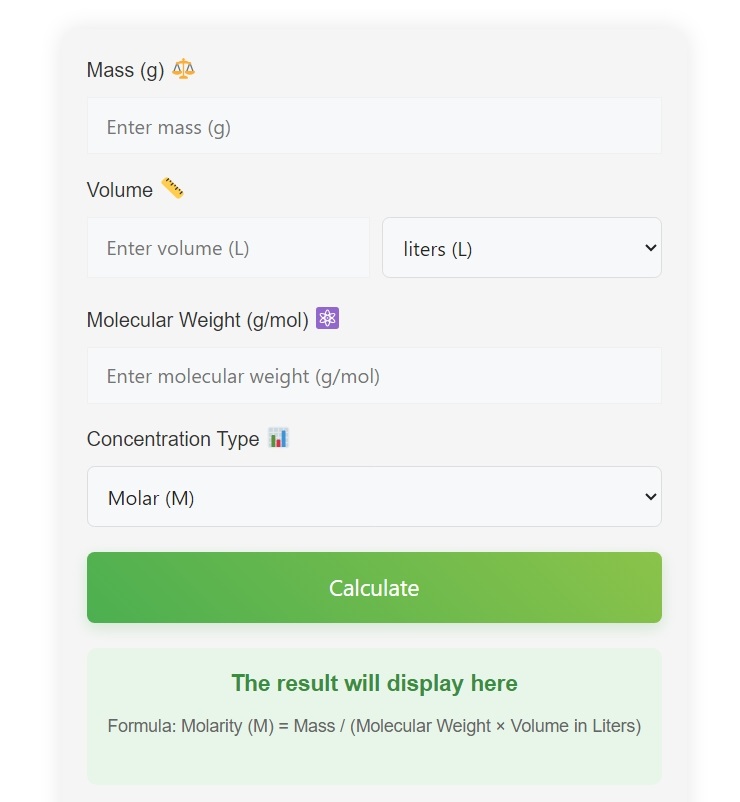Our Molarity Calculator transforms complex chemical calculations into effortless digital operations. Whether you’re working with femtomolar (fM) or molar (M) concentrations, it delivers accurate results with precision and ease.
How to Use the molarity calculator
- Enter mass in grams
- Input volume and select unit (L, mL, µL, or nL)
- Provide molecular weight in g/mol
- Choose desired concentration unit
- Click calculate for instant results
The Calculator’s Features
- Handles 6 concentration units (M to fM)
- Supports 4 volume units (L to nL)
- Instant molarity calculations for solutions using mass and volume inputs
- Supports both standard (M) and micro (μM, nM) concentrations
Who Should Use This Molarity Calculator?

- Research scientists preparing precise solutions
- Students learning chemistry concepts
- Lab technicians making stock solutions
- Quality control specialists verifying concentrations
- Manufacturing teams preparing industrial solutions
Common Questions About Molarity
Now that you’re familiar with our calculator’s features and benefits. Below, I’ve answered common questions about molarity and solution preparation. I’ve included examples that will not only answer your questions but also help you understand chemical concentrations better. Let’s dive in!
What exactly is molarity?
Molarity1 tells you how concentrated your solution2 is – specifically how many moles of your compound are in one liter of solution.
The Molarity Formula Explained

The image above clearly shows the molarity formula. Let’s break it down:
- M is the molarity (concentration of the solution in moles per liter).
- Moles of solute means the amount of substance dissolved.
- Volume of solutions refers to the amount of the solution, typically measured in liters.
How to Calculate Molarity
Traditional Method (Manual):
- Weigh your compound (e.g., 5g NaCl)
- Look up molecular weight (58.44 g/mol for NaCl)
- Measure volume (e.g., 500mL = 0.5L)
- Calculate: 5g ÷ (58.44 g/mol × 0.5L) = 0.171M
Using our Calculator:
- Enter 5 in mass field
- Input 58.44 as molecular weight
- Select 500 mL for volume
- Get instant result: 0.171M
Practical Examples of Calculating Molarity
Example 1: Calculating Molarity from Mass
Problem: You dissolve 5.85 g of sodium chloride (NaCl, MW = 58.5 g/mol) in water to make 500 mL solution. What is the molarity?
Manual Calculation:
- Convert volume to liters: 500 mL = 0.5 L
- Calculate: M = 5.85 g ÷ (58.5 g/mol × 0.5 L)
- Result: M = 0.2 M
Using Calculator:
- Enter mass: 5.85 g
- Enter molecular weight: 58.5 g/mol
- Select volume: 500 mL
- Instant result: 0.2 M
Example 2: Determining Required Mass
Problem: How many grams of potassium chloride (KCl, MW = 74.5 g/mol) are needed to prepare 100 mL of 0.5 M solution?
Manual Calculation:
- Convert volume: 100 mL = 0.1 L
- Calculate mass: m = M × MW × V
- m = 0.5 mol/L × 74.5 g/mol × 0.1 L
- Result: 3.725 g KCl needed
Using Calculator:
- Enter desired concentration: 0.5 M
- Enter volume: 100 mL
- Enter molecular weight: 74.5 g/mol
- Instant result: 3.725 g
By using molarity-calculator.com, you transform a complex molar concentration calculation3 into a simple digital operation, saving time and ensuring accuracy in your laboratory work.
Other Chemistry Calculators you may find helpful
References:
- https://general.chemistrysteps.com/molarity/
- https://sciencenotes.org/solution-definition-in-chemistry/
- https://www.wikihow.com/Calculate-Molarity
